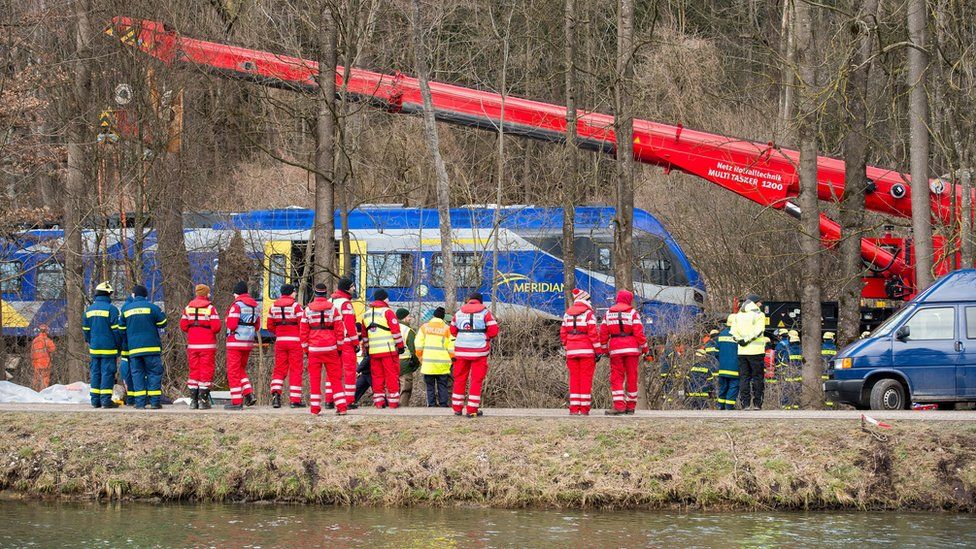Germany train crash: Inquiry focus 'on signalling error'
- Published

A signal controller is at the heart of the German investigation into a Bavarian train disaster which claimed 10 lives, media reports say.
German police have so far rejected as speculation the reports that the controller turned off an automatic safety system shortly before the crash.
But unnamed sources have told German media that a human signalling error may have led to the two passenger trains colliding on a single track on Tuesday.
Controllers ensure trains run safely.
The trains crashed head-on while both were travelling at about 100km/h (62mph) east of Bad Aibling, a spa town about 60km south-east of Munich.
A teenage girl as well as both train drivers and two train guards were among those killed.
Eighteen people were seriously hurt.
Investigators will have to find out why a train that left Holzkirchen travelling east to Rosenheim was on the single track at 06:48, four minutes after it was due to reach its next stop at Kolbermoor, where it would have met the westbound train on a double track.
The westbound train from Rosenheim to Holzkirchen would have left Kolbermoor at 06:45 and would have been expected to be on the single track at the time of the accident.
The controller's role was initially highlighted by newspaper group RedaktionsNetzwerk Deutschland (RND), which quoted sources suggesting the safety system had been switched off to allow the eastbound train through on the single track line because it was several minutes late.
That would also have made the automatic braking system inactive. That braking system, known as PZB, is supposed to kick in when a train runs through a red light and was installed after a 2011 disaster at Magdeburg in which 10 people died.
Sueddeutsche Zeitung, citing a well-informed source, alleged that when the signal controller had realised his mistake it was too late.
A police spokesman rejected the theory as "pure speculation".
"Discard that, we reject that," a spokesman told local broadcaster Bayerischer Rundfunk.
What we know
- The accident occurred on a single-track route between Rosenheim and Holzkirchen at 06:48 local time (05:48 GMT)
- Officials say they assume both train drivers had no visual contact before the crash as the site is on a bend - and therefore crashed into each other largely without braking
- The stretch of line had an automatic braking system designed to halt any train that passed a stop signal. It is not yet known why this failed to stop the crash
- Two of the three data recorders or "black boxes" on board the trains have been recovered
Police said the controller had been questioned on Tuesday as part of the inquiry but insisted there was no immediate suspicion towards him.
However, as the investigation was in its early stages, nothing could be ruled out. It has also emerged that the automatic system was tested last week.
Investigators have so far found two "black box" data recorders and are looking for a third.
Transport Minister Alexander Dobrindt told reporters on Wednesday that the first black box had already been analysed. No technical fault or evidence of driver error had been found on the westbound train, he said.
But the eastbound train's data recorder may be of more importance, as it was travelling late when the two trains crashed head-on.
Police said on Wednesday that the search for victims in the wreckage had been completed. None of those being treated in hospital was in a life-threatening condition, they added.
The trains collided in a hilly and densely wooded region near the Mangfall river, and the difficult terrain made the rescue operation difficult.
Joe Adediran was on board one of the trains and filmed some of the aftermath
A 160-tonne crane arrived at the scene of the disaster on Wednesday, as salvage workers prepared to remove the two mangled trains from the track. The work was expected to last at least two days.
Germany's rail safety mechanism
In case signals fail, German railways are fitted with a final safety guard to prevent crashes.
Cab signalling known as PZB (Punktfoermige Zugbeeinflussung - or "intermittent train control") will set off an alarm in the driver's compartment when the train approaches a red light. If the driver does not respond by pressing a button, the train will brake automatically.
Germany train crash: Aerials show crash site devastation
Other fatal German train crashes
- January 2011: 10 killed at Magdeburg in Saxony-Anhalt when commuter train collides with goods train after driver runs through two signals
- February 2000: Nine dead when overnight train from Amsterdam to Basel crashes near Cologne
- June 1998: 101 killed when a high-speed train with a broken wheel derails and smashes into a bridge at Eschede in Lower Saxony
- Published16 February 2016
- Published9 February 2016